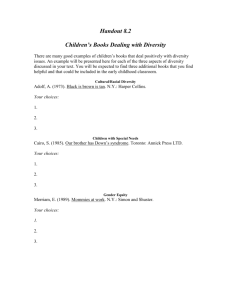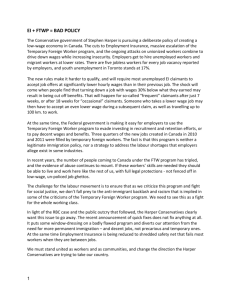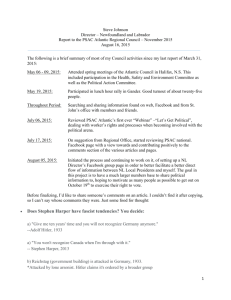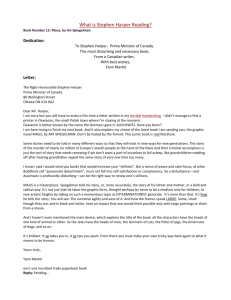Required Reading for the Political Class
advertisement
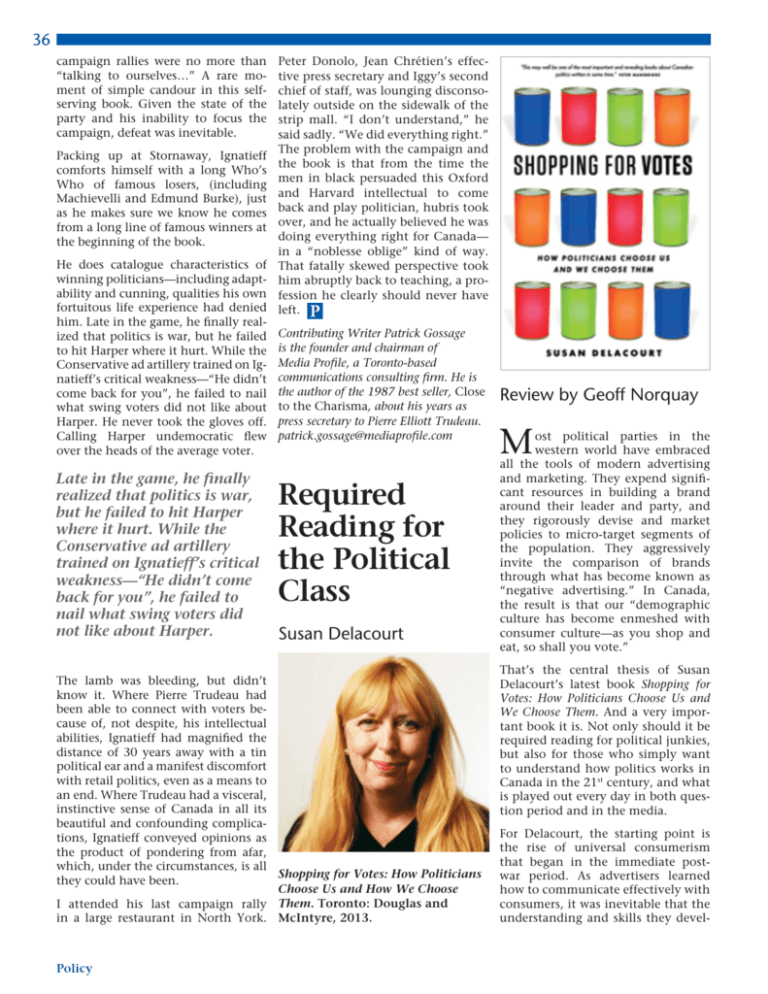
36 campaign rallies were no more than “talking to ourselves…” A rare moment of simple candour in this selfserving book. Given the state of the party and his inability to focus the campaign, defeat was inevitable. Packing up at Stornaway, Ignatieff comforts himself with a long Who’s Who of famous losers, (including Machievelli and Edmund Burke), just as he makes sure we know he comes from a long line of famous winners at the beginning of the book. He does catalogue characteristics of winning politicians—including adaptability and cunning, qualities his own fortuitous life experience had denied him. Late in the game, he finally realized that politics is war, but he failed to hit Harper where it hurt. While the Conservative ad artillery trained on Ignatieff’s critical weakness—“He didn’t come back for you”, he failed to nail what swing voters did not like about Harper. He never took the gloves off. Calling Harper undemocratic flew over the heads of the average voter. Late in the game, he finally realized that politics is war, but he failed to hit Harper where it hurt. While the Conservative ad artillery trained on Ignatieff’s critical weakness—“He didn’t come back for you”, he failed to nail what swing voters did not like about Harper. Peter Donolo, Jean Chrétien’s effective press secretary and Iggy’s second chief of staff, was lounging disconsolately outside on the sidewalk of the strip mall. “I don’t understand,” he said sadly. “We did everything right.” The problem with the campaign and the book is that from the time the men in black persuaded this Oxford and Harvard intellectual to come back and play politician, hubris took over, and he actually believed he was doing everything right for Canada— in a “noblesse oblige” kind of way. That fatally skewed perspective took him abruptly back to teaching, a profession he clearly should never have left. Contributing Writer Patrick Gossage is the founder and chairman of Media Profile, a Toronto-based communications consulting firm. He is the author of the 1987 best seller, Close to the Charisma, about his years as press secretary to Pierre Elliott Trudeau. patrick.gossage@mediaprofile.com Required Reading for the Political Class Susan Delacourt The lamb was bleeding, but didn’t know it. Where Pierre Trudeau had been able to connect with voters because of, not despite, his intellectual abilities, Ignatieff had magnified the distance of 30 years away with a tin political ear and a manifest discomfort with retail politics, even as a means to an end. Where Trudeau had a visceral, instinctive sense of Canada in all its beautiful and confounding complications, Ignatieff conveyed opinions as the product of pondering from afar, which, under the circumstances, is all Shopping for Votes: How Politicians they could have been. Choose Us and How We Choose I attended his last campaign rally Them. Toronto: Douglas and in a large restaurant in North York. McIntyre, 2013. Policy Review by Geoff Norquay M ost political parties in the western world have embraced all the tools of modern advertising and marketing. They expend significant resources in building a brand around their leader and party, and they rigorously devise and market policies to micro-target segments of the population. They aggressively invite the comparison of brands through what has become known as “negative advertising.” In Canada, the result is that our “demographic culture has become enmeshed with consumer culture—as you shop and eat, so shall you vote.” That’s the central thesis of Susan Delacourt’s latest book Shopping for Votes: How Politicians Choose Us and We Choose Them. And a very important book it is. Not only should it be required reading for political junkies, but also for those who simply want to understand how politics works in Canada in the 21st century, and what is played out every day in both question period and in the media. For Delacourt, the starting point is the rise of universal consumerism that began in the immediate postwar period. As advertisers learned how to communicate effectively with consumers, it was inevitable that the understanding and skills they devel- oped would migrate to the civic side tire market intelligence operation inof the street and to public policy. house within the party, but he also played a key role in crafting the “overShe charts the growing links between all ‘campaign narrative’—a combinaadvertising and politics through the tion of polling intelligence, policy, imcontributions of the early Canadian age and advertising, all in one linked pioneers: Conservatives Dalton Camp, package.” Advances in technology Allister Grosart and Allan Gregg, and enabled the Conservatives to move Liberals Keith Davey, Jerry Grafstein from a focus on “winnable geographic and Martin Goldfarb. Ultimately, the regions to winnable individuals.” And understanding of consumer and citiit worked. Harper won the 2006 eleczen markets merged and led to the tion and has not looked back. development of typologies, essentially “brands” of people, defined by their To be sure, the ultimate outcome of beliefs, attributes and values as both the hyper slicing and dicing of the consumers and voters. electorate is not without consequences. In the final chapter, Delacourt It was only a short step from there for begins to unpack some of the implipolitical strategists to begin probing cations, and suggests we may be bewhat people wanted from their poliginning to see “the true democratic tics as well as their supermarkets. As price of seeing civic life in the same Delacourt puts it, “The 1990s would terms as consumer culture.” see a stampede toward these notions of people, politics and products as There is the constant campaign, fubrands, and a rush by political and elled by the constant repetition of private marketers to set up “niche” clear and concise messages. There is markets to suit this fragmented politics and governance reduced to population.” a series of transactions with voters— The genius who refined this approach “deep discounts on their taxes, snapfor Stephen Harper was Patrick Mut- py slogans on their legislation, image tart, who had learned the lessons of over policy discussions. And there is Margaret Thatcher, Tony Blair and the call to honour and revere the icons “New Labour,” the Republicans under of nationhood—the military, the War Richard Nixon and Ronald Reagan, as of 1812, hockey and Tim Horton’s. well as Australia’s John Howard. He As Delacourt notes, perhaps the bigdeveloped the archetypes that helped gest risk here is that citizens may to elect the Conservatives in 2006: reach the check-out counter of the • ‘”Dougie,” along with his house, his new consumer politics and check out car and the Canadian Tire where he altogether. On the other hand, if you only need 200,000 more votes to win, worked; • “Rick and Brenda,” a common-law and you know where they are, and couple with working class jobs, how to get them…. who could probably be persuaded to swing to the Conservatives, if the party pressed the right buttons with their bread-and-butter concerns about taxes or the costs of keeping up their homes; Contributing Writer Geoff Norquay, a former communications director for Stephen Harper in opposition, is a principal of the Earnscliffe Strategy Group. • “ Fiona and Marcus”…were a high- geoff@earnscliffe.ca income, childless couple who lived in an expensive condominium, who didn’t mind paying high taxes and would probably always vote Liberal; • “ Zoe,” a single, urban female, fond of yoga and organic food, living in a high rise in Toronto, who was probably a lost cause—nothing was likely to lure her away from Liberals or New Democrats.” Not only did Muttart bring the en- He’s Prime Minister: Get Used to It Paul Wells The Longer I’m Prime Minister: Stephen Harper and Canada 2006. Toronto: Random House Canada 2013 Review by James Baxter I t is hard to determine whether Paul Wells wrote The Longer I am Prime Minister: Stephen Harper and Canada 2006—from a standpoint of admiration for Canada’s arch incrementalist or with an acute case of Stockholm Syndrome. What is clear is that Wells has written one of the most readable and thorough accounts of a man on a mission to change Canada forever. Wells readily admits that he set out to write a book that he knew would appeal to conservatives, particularly the impatient ones, while at the same time rub the noses of liberals and progressives in the fact that, despite making up at least 60 per cent of the voting public, they are impotent, that resistance is futile. In large measure, he is successful in both missions. As an author, Wells has created a political book that should be read by every Canadian with a shred of political awareness. Harper’s supporters will enjoy a glimpse into the planning behind the tactics. Harper’s detractors will be forced to look beyond the caricature of the robotic control freak and confront their greatest fear; November/December 2013 37


